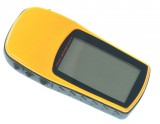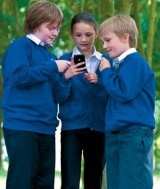Introduce your class to a global game of hide and seek, learn outdoors and develop ICT skills while you’re at it...
Global Positioning Systems (GPS) are becoming very common these days. Hill walkers use them, cars come with satellite navigation and many modern mobile phones are GPS enabled. But did you know that people around the world have hidden over 1.5 million pieces of geo-located Tupperware? These are called geocaches and are part of a global game of hiding and seeking treasure using GPS.
A person can hide a geocache anywhere in the world, pinpoint its location using GPS technology and then share the geocache’s existence and location online at geocaching.com. Anyone with a GPS device can then try to find the geocache.
Educaching is similar to geocaching but the teacher hides the caches on a temporary basis (maybe in the school grounds or local community). Educaches normally contain challenges linked to learning outcomes and thematic learning.
Geocaching and Educaching are great activities to do with young people. Finding a geocache can add a different purpose to your journey and encourages you (and your learners) to look at your surroundings in a completely different way.
Don’t forget, as well as being an exciting activity to do in the countryside there are also lots of geocaches hidden in urban areas.
The use of GPS, just like the use of any technology, should be part of a blended learning experience for children.
Recently, I watched a class doing a project on Roman villas. The teacher introduced the topic to the class using an interactive presentation and some textbook resources. The class then went out educaching in the school grounds to find caches that the teacher had hidden that morning.
At each cache, the children recovered part of an archaeological floor plan of a Roman villa and some other Roman facts and figures. Back in the classroom they pieced the floor plan together like a large jigsaw puzzle and then sketched what they thought the outside of the building might look like.
Some of the children then chose to re-model their villa in Google Sketch Up while others produced a neat, annotated diagram.
The final part of the project was video conferencing with a Roman (well, someone dressed up as one anyway!) where the children asked questions about what it would be like to live in the villa. They then reflected on their learning using their class blogs.
What I like about the approach I have described above is that the learning objective could be achieved without going outside, without the use of technology and without the use of GPS. But by using this blended learning approach with a variety of pedagogies it really adds value to the experience and caters for a wide range of learning styles.
 GPS and Geocaching can be linked to the curriculum in lots of ways. Here are a few examples:
GPS and Geocaching can be linked to the curriculum in lots of ways. Here are a few examples:
LITERACY: Describing what you feel like when you find your first geocache can help develop descriptive writing. Formal writing can be developed by writing to land owners and councils to see if you can hide a cache on their land. Factual and instructional writing can be developed by describing how you find a cache.
NUMERACY: Geocaching offers lots of opportunities to reinforce core skills, such as direction, orientation and degrees. GPS is also a great tool for teaching distance and estimation in your school grounds.
SCIENCE: It’s a useful introduction to studying GPS systems, satellites and space.
SOCIAL SUBJECTS: Looking at maps and studying the local area is a natural accompaniment to geocaching. Some GPS have topographical maps built in to them.
TECHNOLOGY: Designing and hiding your own geocache can be very fulfilling (see below).
DON’T FORGET! If you hide your own educaches in the school grounds you canconceal just about any learning content in them. This might include facts, figures, puzzles, clues and even sounds.
A travel bug is a traceable tag with a unique code. They are left in caches and then carried from cache to cache (or person to person) in the real world. You can follow a travel bug’s progress online at geocaching.com. Travel bugs can be given tasks to achieve. For example, a task might be that the bug needs to visit ten countries, or get to the Southern Hemisphere, or get to your twinned school in France, or even to get to Antarctica. Each travel bug has its own digital travel diary that follows its movements.
It can be great fun to follow travel bugs with your class and you can link them to lots of areas of the curriculum. This might include researching the places where they end up, working out how far they have travelled and learning some key phrases from local languages. Of course you also have to work with your class to decide on what your travel bug’s mission will be in the first place.
 If you want to use geocaching as a whole class, crosscurricular project then you might consider doing some or all of the following…
If you want to use geocaching as a whole class, crosscurricular project then you might consider doing some or all of the following…
• Explain to your class what geocaching is. This YouTube video might help you http://goo.gl/P266
• See if there are any geocaches near your school. You can find out by entering your school postcode into geocaching.com
• Arrange a time to go out with your class and find some caches.
• Remember that many caches are linked to the history and geography of an area. This is an ideal opportunity to do a bit of extra research.
• Consider making and hiding your own school cache.
• Use a map or satellite image of your local area to decide on a good place to hide your school cache.
• Go out and investigate the place where you think you might like to hide your cache. Then find a safe place to hide it.
• Design a cache container that will blend in with your hiding place all year round (remember colours change with seasons).
• Decide what you will leave in your cache to make it unique to your school and local area and don’t forget to leave a travel bug with a mission!
• Research and write to the local landowner to explain what you are doing and get permission to hide your cache.
• Hide your cache and register it on geocaching.com
• Monitor your cache to see who finds it and where they come from.
• Send the GPS home with your students over a weekend to promote some intergenerational learning between children, parents and grandparents.
http://www.geocaching.com
The official geocaching website which contains all the information you need to get star ted
http://www.educaching.com
Advice on Educaching in the classroom
http://www.trailsoptional.com/tag/geoc
aching-2 Jen Deyenberg’s charts his geocaching projects with children
http://www.olliebray.com
More examples of geocaching and other ICT projects from Ollie Bray’s website
Kindness is contagious - give your colleagues a boost by recognising their efforts
Ace-Classroom-Support
Join the tribe with a stone age forest school
Ace-Classroom-Support
